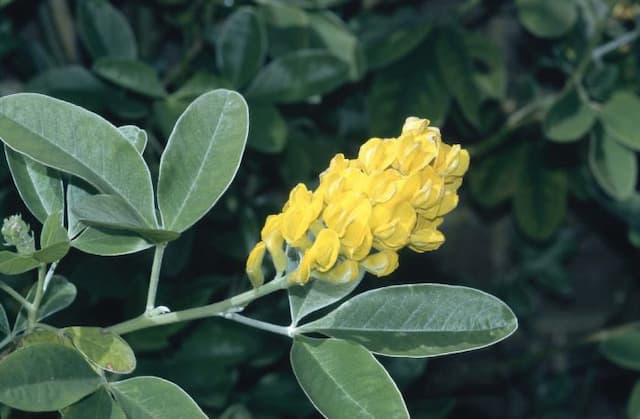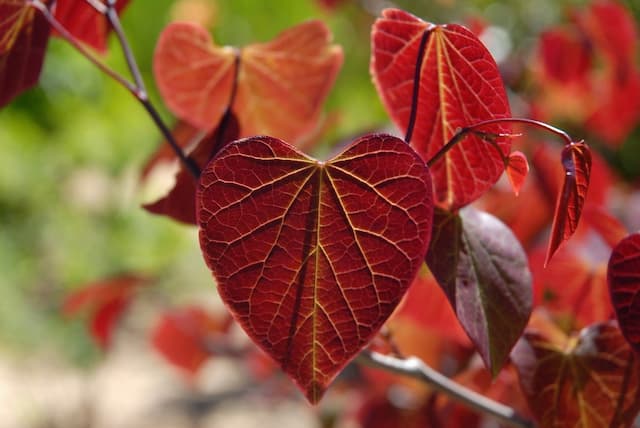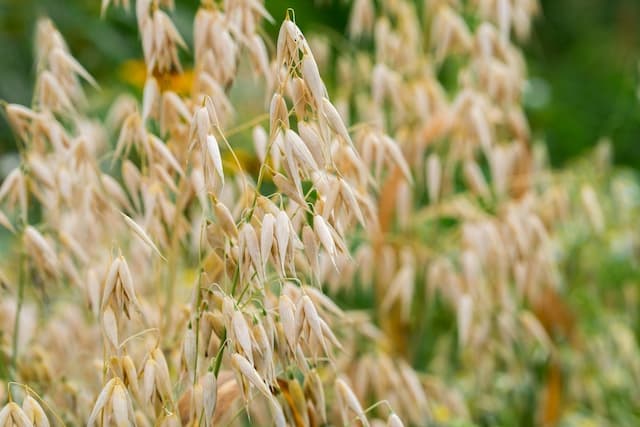Birdsfoot Trefoil Lotus corniculatus

ABOUT
The common name for Lotus corniculatus is Bird's-foot Trefoil, which is a perennial plant widely recognized for its distinctive foliage and flower characteristics. The leaves of the Bird's-foot Trefoil are compound, typically consisting of five leaflets; however, the lower pair of leaflets are found at the base of the stalk, which gives the appearance that the leaf is actually comprised of three leaflets. These leaflets are oval to oblong in shape, with smooth edges, offering a rich green hue to the plant. The Bird's-foot Trefoil blooms with small, bright yellow flowers that are clustered together in groups. These flowers eventually mature into fruits which resemble multiple small pods radiating from a central point, reminiscent of a bird's foot, hence the name. The plant adapts well to a variety of soil conditions and tends to form dense mats which can be found covering the ground, making it a common sight in many regions. The flowers not only add a splash of color but also attract a variety of pollinators, adding to the ecological diversity of the areas where this plant grows.
About this plant
 Names
NamesFamily
Fabaceae.
Synonyms
Bird's-foot Trefoil, Bird's-foot Deervetch, Eggs and Bacon, Devil's Claws, Granny's Toenails, Hen and Chickens, Bacon and Eggs, Dutchman's Clogs.
Common names
Lotus alpinus, Lotus ambiguus, Lotus caucasicus, Lotus corniculatus var. tenuifolius, Lotus corniculatus var. frondosus, Lotus corniculatus var. minor, Lotus corniculatus var. alpestris, Lotus dorycnium, Lotus tenuis, Lotus major, Lotus repentis, Lotus hispidus, Lotus glaber, Lotus uliginosus, Lotus comiculatus, Lotus hirsutus, Lotus strictus, Lotus jacobaeus, Lotus norvegicus, Lotus sibiricus.
 Toxicity
ToxicityTo humans
Birdsfoot trefoil (Lotus corniculatus) is generally not considered toxic to humans and is not known to cause serious poisoning if ingested; indeed, some parts of the plant have been used in traditional herbal remedies. However, it's important to note that eating any plant material that has not been verified as safe for human consumption can pose risks, including potential allergic reactions or gastrointestinal discomfort.
To pets
In pets, specifically horses, birdsfoot trefoil is actually considered a nutritious and non-toxic forage option. However, as with any dietary change or plant ingestion, individual animals may have unique sensitivities or allergic reactions. Owners should monitor their pets' reactions when introducing new plants into their diet. There is no widespread documentation of birdsfoot trefoil causing toxicity in common domestic pets like dogs and cats. As always, moderation is key and pet owners should ensure their pets have a balanced diet.
 Characteristics
CharacteristicsLife cycle
Perennials
Foliage type
Deciduous
Color of leaves
Green
Flower color
Yellow
Height
1-2 feet (30-60 cm)
Spread
1-2 feet (30-60 cm)
Plant type
Herb
Hardiness zones
4
Native area
Europe
Benefits
 General Benefits
General Benefits- Nitrogen Fixation: Lotus corniculatus, commonly known as birdsfoot trefoil, has the ability to fix atmospheric nitrogen, enriching the soil and reducing the need for chemical fertilizers.
- Forage for Livestock: It is a valuable forage crop for livestock, providing a high-quality, protein-rich feed that is particularly beneficial for ruminants.
- Erosion Control: Its extensive root system helps to stabilize soil and prevent erosion, making it useful for land reclamation and improving soil structure.
- Habitat for Wildlife: The plant serves as a habitat and food source for various wildlife species, including pollinators like bees and butterflies.
- Drought Tolerance: Birdsfoot trefoil is known for its drought resistance, making it a suitable plant for xeriscaping and in areas with lower water availability.
- Low Maintenance: It is generally low maintenance and requires minimal care once established, which can reduce landscaping costs.
- Landscape Aesthetics: With its bright yellow flowers, birdsfoot trefoil can enhance the visual appeal of natural landscapes, meadows, and garden settings.
 Medical Properties
Medical Properties- Anti-inflammatory: Lotus corniculatus has been used for its anti-inflammatory properties.
- Sedative: The plant has components that can act as a sedative.
- Antispasmodic: It is believed to have antispasmodic effects, which can ease muscle spasms.
- Astringent: The astringent properties of Lotus corniculatus can help in the contraction of skin cells and other body tissues.
 Air-purifying Qualities
Air-purifying QualitiesThis plant is not specifically known for air purifying qualities.
 Other Uses
Other Uses- As a fabric dye: Birdsfoot trefoil can be used to produce a yellow dye for coloring fabrics.
- In butterfly gardens: The plant is known to attract various species of butterflies, thus supporting local biodiversity.
- Livestock feed: It is used as a high-protein forage crop for livestock such as cattle, sheep, and goats.
- Erosion control: Birdsfoot trefoil is planted on slopes and waterways to prevent soil erosion due to its extensive root system.
- Green manure: Farmers cultivate birdsfoot trefoil as a cover crop, which they later plow into the soil as green manure to improve soil fertility.
- Beekeeping: It is an excellent source of nectar, which makes it highly beneficial for beekeepers looking to boost honey production.
- Soil improvement: Birdsfoot trefoil fixes nitrogen in the soil, improving nutrient levels and reducing the need for chemical fertilizers.
- Garden aesthetics: Due to its bright yellow flowers, the plant is sometimes used for aesthetic purposes in ornamental gardens.
- Bioremediation: The use of this plant may contribute to the bioremediation of contaminated soils by stabilizing heavy metals.
- Ground cover: Birdsfoot trefoil can be used as low maintenance, drought-resistant ground cover in landscaping projects.
Interesting Facts
 Feng Shui
Feng ShuiThe Birdsfoot trefoil is not used in Feng Shui practice.
 Zodiac Sign Compitability
Zodiac Sign CompitabilityThe Birdsfoot trefoil is not used in astrology practice.
 Plant Symbolism
Plant Symbolism- Prosperity: Lotus corniculatus, commonly known as Birdsfoot Trefoil, is often associated with wealth and prosperity, potentially due to its lush growth and bright yellow flowers that resemble coins.
- Protection: In some traditions, this plant is believed to offer protection, perhaps because it can thrive in challenging conditions, symbolizing resilience and safety.
- Grounding: The Birdsfoot Trefoil's strong root system represents grounding and stability, hinting at a connection to the earth and a sturdy foundation.
- Happiness: The cheerful appearance of its yellow blooms can be symbolic of happiness and joy, often used to brighten up landscapes and gardens.
- Union: Its characteristic leaf formation, which entails three leaflets, is sometimes seen as a symbol of unity and the interconnectedness of all things.
 Water
WaterBirdsfoot trefoil (Lotus corniculatus) prefers consistent moisture, especially during its active growing season in the spring and summer. It should be watered deeply once a week, ensuring that water penetrates the soil to reach the root zone. Use about one gallon of water per plant for each watering session. However, allow the soil surface to dry out slightly between waterings to prevent waterlogging. In hot or windy weather, you may need to water more frequently, while in cooler or rainy periods, watering can be reduced.
 Light
LightBirdsfoot trefoil thrives in full sunlight, which means it should receive at least six hours of direct sunlight each day. The ideal spot for planting birdsfoot trefoil would be an area that is not shaded and receives ample sunlight throughout the day. This plant can tolerate partial shade, but its blooming and growth might not be as prolific as when it is grown in full sun.
 Temperature
TemperatureBirdsfoot trefoil grows best in temperatures ranging from 60 to 77 degrees Fahrenheit but can tolerate a wider range from roughly 50 to 85 degrees Fahrenheit. It can endure short periods of colder temperatures down to about 20 degrees Fahrenheit, but frost can damage young growth. For optimal growth and flower production, maintaining temperatures within its preferred range will yield the best results.
 Pruning
PruningPruning birdsfoot trefoil is necessary to maintain its shape and encourage new growth. Trim back the foliage after the initial flowering to stimulate a second bloom and tidy up the plant. Pruning is best done in late summer or early fall after the plant has finished most of its blooming. Do not prune in late fall or winter, as this can expose the plant to cold damage.
 Cleaning
CleaningNot needed
 Soil
SoilBirdsfoot trefoil thrives in a well-draining soil mix with a pH between 6.0 and 7.5. To create an ideal soil environment, mix garden soil with compost and a little sand to improve drainage. Regular garden soil can often suffice, but the addition of organic matter encourages robust growth.
 Repotting
RepottingBirdsfoot trefoil is a perennial and does not typically require repotting as it is often grown outdoors. However, if grown in containers, consider repotting every two to three years to refresh the soil and provide room for growth.
 Humidity & Misting
Humidity & MistingBirdsfoot trefoil is not particularly humidity-sensitive and can tolerate a wide range of humidity levels typical of outdoor environments.
 Suitable locations
Suitable locationsIndoor
Place in bright light, water moderately.
Outdoor
Full sun, well-draining soil, water as needed.
Hardiness zone
4-9 USDA
 Life cycle
Life cycleBirdsfoot trefoil (Lotus corniculatus) begins its life cycle with seed germination, typically occurring in spring when soil temperatures rise and moisture is ample. Following germination, the seedling emerges and develops a taproot system and a rosette of trifoliate leaves. The plant enters a vegetative growth stage, producing more leaves and stems while establishing itself. Flowering occurs in late spring to summer, presenting bright yellow flowers that attract pollinators and ultimately lead to pod-like fruit formation. These fruits mature to release seeds, which can contribute to the spread and perpetuation of the species. Birdsfoot trefoil can also spread vegetatively through its creeping stems (stolons) that can root at the nodes, forming new plants.
 Propogation
PropogationPropogation time
Spring to Summer
Birdsfoot Trefoil, commonly known as Lotus corniculatus, can be effectively propagated through seed germination. The best time for sowing the seeds is in the spring after the threat of frost has passed, usually in the late winter to early spring months. The propagation by seed involves selecting a well-draining soil bed and sowing the seeds at a depth of about 1/4 inch (about 6 millimeters). It's important to keep the soil consistently moist until germination, which usually occurs within 2 to 3 weeks. After the seedlings have developed a few true leaves and are strong enough, they can be transplanted to their final growing location, ensuring they are spaced adequately to allow for growth and air circulation.









